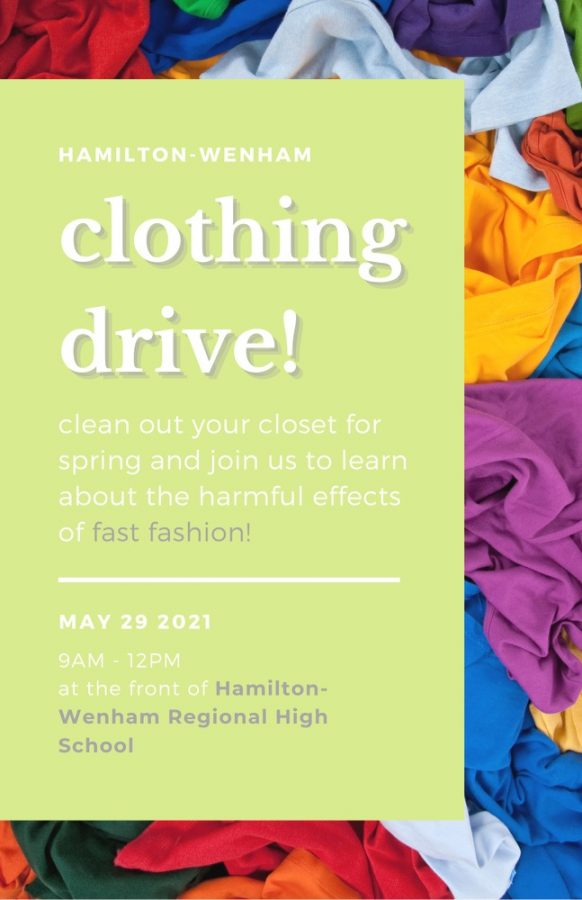The High Price of Fast Fashion
On May 29, 2021, participate in the clothing drive Hamilton-Wenham High School to address the growing issue of fast fashion.
Fast fashion is inexpensive and convenient; its low price tags often catch our eye. We’re all guilty of it; buying a shirt or a pair of shorts at a low price is alluring. Fast Fashion allows us to accommodate the world’s passion for fashion at an affordable convenience, but it does come at a price.
Inexpensive and widely available garments have changed the way people buy and dispose of clothing. By selling large quantities of cheaply made clothing, fast fashion has emerged as a dominant business model, causing garment consumption to skyrocket. While many see fast fashion as the “democratization” of fashion in which the latest styles are available to all classes of consumers, the human and environmental health risks associated with inexpensive clothing are hidden throughout the lifecycle of each garment. In a world with an increasing concern for environmentalism and social justice, we must examine the industries that we interact with every day.
Fast fashion is a wasteful industry. According to the Fast Fashion Waste report, almost 80 million pieces of clothing are purchased each year, giving 1.2 trillion dollars to the fashion industry annually. The majority of clothing assembly occurs in China and Bangladesh. Yet, the U.S. consumes more clothing and textiles than any other nation. Approximately 85% of clothing Americans purchase adds up to nearly 3.8 billion pounds of textile waste–which often ends up in landfills across the nation. Almost 17 million tons of textile waste ended up in landfills, according to data from the Environmental Protection Agency, making up 5.8 percent of the total MSW generation that year
The fast-fashion industry is also the 2nd largest consumer of water, requiring 700-2000 gallons of water to produce garments. Some brands use synthetic fibers like polyester, nylon, and acrylic– all of which can take hundreds of years to biodegrade. A 2017 report from the International Union for Conservation of Nature estimated that 35% of all microplastics in the ocean come from synthetic textiles like polyester, nylon, and acrylic.
Not only does the fast fashion industry waste tremendous resources in production, but it also contributes to the increasing rates of carbon emissions. According to the UN Framework Convention on Climate Change, emissions from textile manufacturing alone are projected to skyrocket by 60% by 2030. Synthetic materials like polyester, acrylic, and nylon– made from crude oil– pollute the oceans, cause oil spills, and release toxic greenhouse gases into the atmosphere.
Fast fashion not only impacts our planet, but it also affects the people living on it. Mistreatment of workers’ human rights and wellbeing, as well as child labor, are common in the fast fashion business. In nations such as India, Pakistan, Bangladesh, Chile, and Thailand, where clothing production is outsourced to, child labor and mistreatment of workers is commonplace. Mehreen Tariq Ghani, a writer for medium.com calculates a statistic from UNICEF: “According to a report by UNICEF, 170 million children are employed in the garment industry. Hands that should be holding books and pens are toiling 12 hours a day, sewing, stitching, and dyeing garments to satisfy global consumer demand for fast fashion. This is the reality for 11% of children in the world.” In addition, accidents such as fires, disease, injuries, and abuse are frequent in the textile industry. In 2013, the collapse of the Rana Plaza killed 1134 and injured more than 2500 garment workers in Dhaka, Bangladesh. This tragedy revealed the unacceptable working conditions of the fashion industry to the world. There were unsafe conditions of the building, but factory owners threatened not to pay the workers who refused to return to work. The collapse of the Rana Plaza was one of the most deadly garment factory accidents in history, all for a tragedy that was driven by the desire for profit.
The idea of creating a sustainable or ethical wardrobe is, without a doubt, a daunting one. There’s the prospect of not being able to wear the brands you’re used to and limiting your choices in terms of trends, brands, and expenses. All of these concerns are, of course, valid, but it isn’t as hard as you might think to get started on a sustainable wardrobe — and it’s worth it in the long run. A website created by three women called sustainyourstyle.org advocates against fast fashion and provides users with other sustainable options to shop. They encourage us to buy fewer clothes: “The most environmentally sustainable jacket is the one that’s already in your closet…” said Patagonia’s Chief Product Officer Lisa Williams. They encourage us to buy clothing from sustainable brands. Nonetheless, sustainable brands will not necessarily cost more than brand-name clothing, for which people sometimes pay high prices for the image, but rarely for the quality or the sustainability. Buy better quality clothing. If people stop buying poor quality, it will push brands to improve the quality of their garments. It will also allow us to keep our clothes longer, which is good for our wallets and the environment. Instead of throwing out clothing, we should try to repair them, donate them, give them to friends or family, and even put our used clothing in local donation bins, which usually are in grocery store parking lots and schools. By buying more sustainably, reducing our environmental impact, and repairing or recycling clothing, we can reduce the damage that the fashion industry has had on our environment.
On May 29th, 2021 at Hamilton-Wenham High School, there will be a clothing drive designed to address the growing issue of fast fashion. We will take all of the clothes from the drive and distribute them to our local thrift stores, to encourage recycling and discourage the consumer mindset. If you have any questions or want to know more information, email us at:

Hadley Braillard is a senior at Hamilton-Wenham Regional High School. She has been a part of the General Consensus since her junior year and enjoys being...











Leo Kagan • May 29, 2021 at 5:08 pm
Great article!